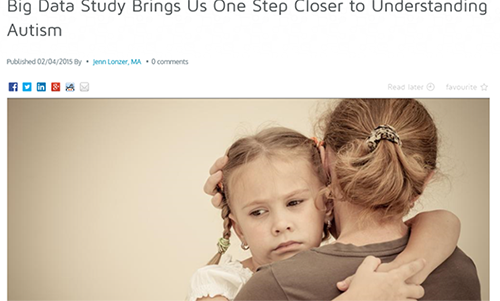
University of Warwick big data study isolates differences between autistic and non-autistic brains.
My daughter was diagnosed with autism spectrum disorder (ASD) when she was 9. For years, she passed as a quirky, sensitive, savant-like kid. Her teachers loved her. Everyone thought she was a joy – except those closest to her.
The day we received her diagnosis, we marched straight to the school to request an Individualized Education Plan (IEP). When we described her behavior outside of school – the violent meltdowns, the bullying, the lack of interest in imaginative play, the power-dance around homework, the crying and screaming as her only forms of communication, the self-inflicted injury – the principal, teachers, and guidance counselors on our daughter’s education team blamed us.
That’s right: they told us our daughter didn’t have special needs – she had bad parents.We’d spent thousands of dollars on testing and no one believed us.
There is science behind the battery of tests Cleveland Clinic Children’s Center for Autism gave my daughter. And for a research-geek like myself, science is oddly comforting. It’s regimented in a way that emotions aren’t.
So, when I read the results of a rigorous statistical analysis from the University of Warwick, which point to significant differences in brain functioning between people with and without ASD, I feel oddly reassured.
Perhaps I’m not just an ineffective parent – perhaps our experience of autism is real.
Autism: Prevalence and Symptoms
The scientific community has been able to identify common symptoms of autism, but not the causes of autism or its symptoms. Here’s a brief summary of what we knew about autism before the release of University of Warwick study.
Autism is a bio-neurological developmental disability that affects 1 in 68 children in the United States. Symptoms of autism vary significantly from person to person, as there is great variability in severity and access to treatment. However, people with autism may communicate, behave, and learn in ways that are differentthan their typically developing peers. People with ASD may have difficulty relating to others. They may avoid eye contact and appear unaware when people talk to them. They may have trouble expressing their needs, and adapting to changes in routines. They may have unusual reactions to sensory input, and may display repetitive behaviors.
Big Data Enables Whole-Brain Research
Warwick researchers used big data – available through the Autism Brain Imaging Data Exchange (ABIDE) – to compare brain functioning in 523 people diagnosed with autism and 452 neurotypical controls.
Using a Brain-Wide Association Analysis (BWAS) methodology, developed at the University of Warwick, researchers compiled, compared, and contrasted computer models of both autistic and non-autistic brains. The Warwick team found concrete examples of differences in cortical functional connectivity, and were able to identify regions of the brain that may significantly contribute to the symptoms of autism.
Specifically, the autistic brain models showed a neural basis for autism, with reduced functional connectivity in areas of the brain thought to be responsible for facial expression processing, emotion, communication, and thetheory of mind.
According to the Internet Encyclopedia of Philosophy, the theory of mind, which was implicated in the BWAS analysis, is a “branch of cognitive science that investigates how we ascribe mental states to other persons, and how we use the states to explain and predict their actions…”
According to Dr. Stephen M. Edelson, executive director of the Autism Research Institute:
…many autistic individuals do not understand that other people have their own plans, thoughts, and points of view… By not understanding that other people think differently than themselves, many autistic individuals may have problems relating socially and communicating to other people. That is, they may not be able to anticipate what others will say or do in various situations.
While it’s important to remember that big data studies can establish correlations, but not causation, when it comes to complex neurological disorders like autism, correlations are better than nothing.
One Step Closer to Understanding
As parents, teachers, therapists, and physicians try to wrap their heads around what a diagnosis of autism might mean, studies like this contribute to suspicions that there may be some biological or neurological basis for the symptoms of autism.
Last week, our daughter’s therapist told us that we needed to moderate our expectations of our daughter since she has autism. The thing is, over the past 6 months (since diagnosis), we’ve asked 20 or so different specialists about what appropriate expectations might be and not one of them could tell us.
By identifying differences in brain functionality, big data studies like this help broaden our understanding of how the autistic brain works. Which is one step closer to setting appropriate expectations for behavior and treatment.